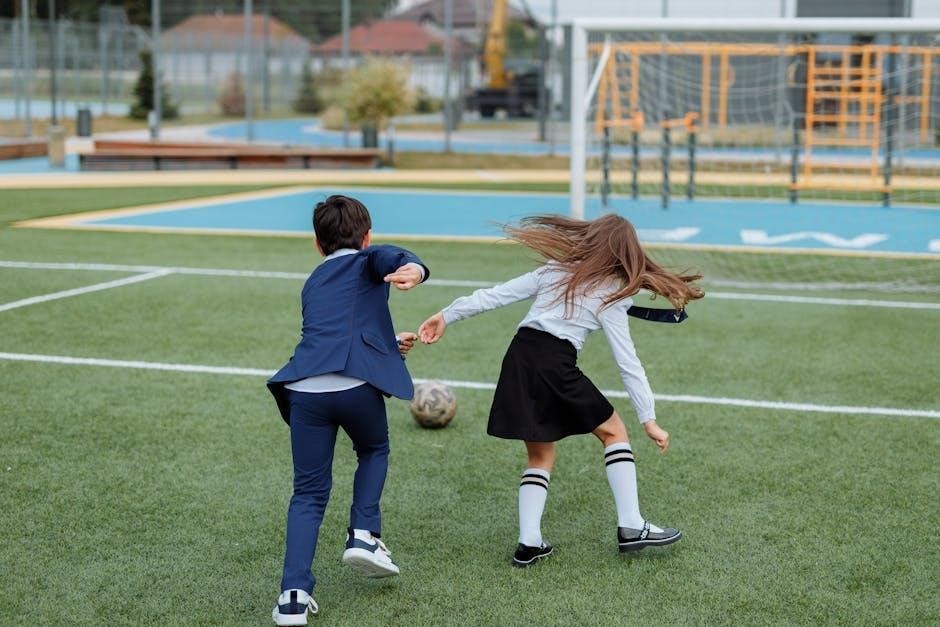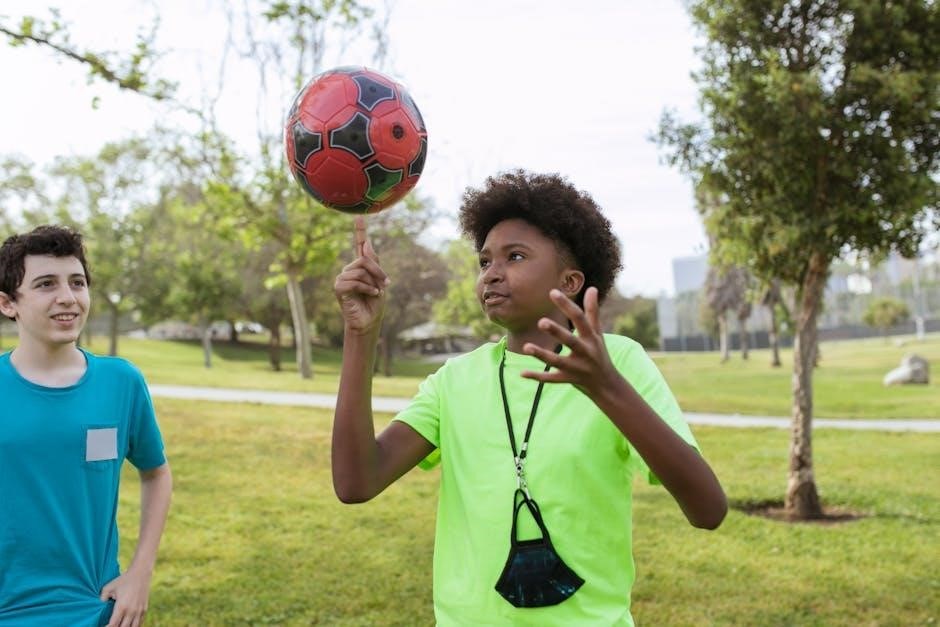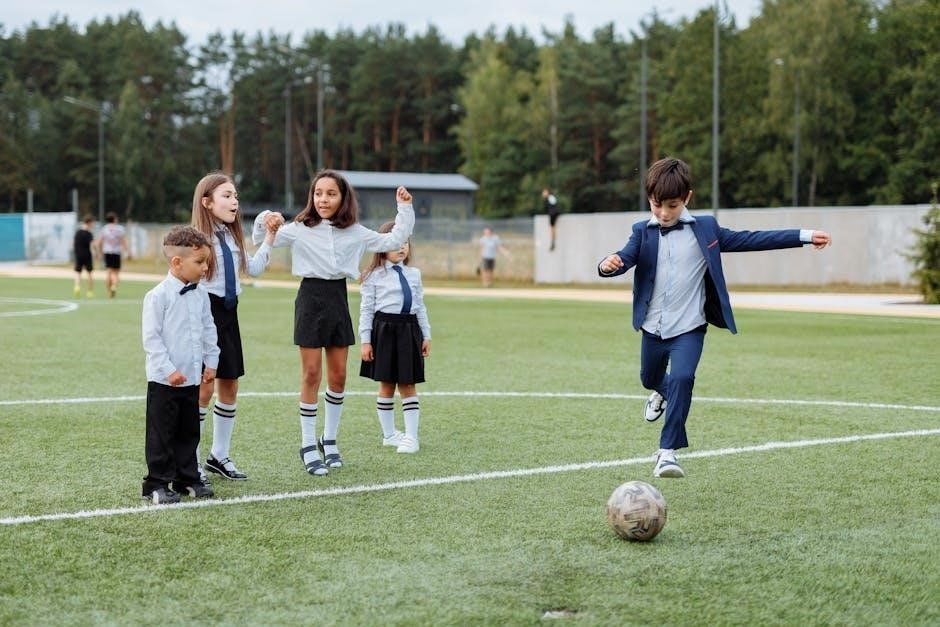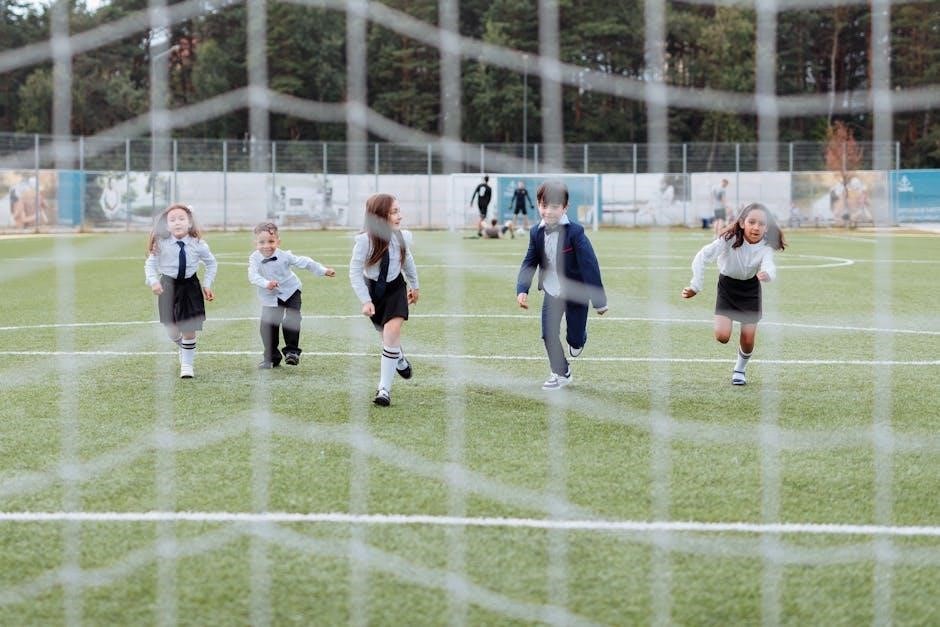High School Soccer Tryout Plan: A Comprehensive Guide
This guide provides high school soccer coaches with a structured approach to planning and executing tryouts․ It emphasizes maximizing player evaluation and team building‚ fostering a positive environment․ Proper planning is vital for effective tryouts‚ allowing coaches to identify talent and set the stage for success․
Pre-Tryout Preparation
Prior to the tryouts‚ setting clear objectives is paramount․ Define the desired qualities in players‚ including technical skills‚ tactical understanding‚ physical fitness‚ teamwork‚ and character․ These objectives should align with the team’s playing style and seasonal goals‚ guiding the evaluation process and ensuring player selection fits the team’s philosophy․
Develop a detailed schedule outlining the tryout structure and timeline‚ considering facility availability‚ equipment‚ and participant numbers․ Divide sessions into segments for warm-ups‚ skill assessments‚ game simulations‚ and cool-downs‚ allowing for breaks to prevent fatigue․ A well-structured schedule ensures organization and maximizes efficiency․
Establish evaluation criteria aligned with the objectives‚ encompassing technical skills‚ tactical understanding‚ physical fitness‚ game intelligence‚ teamwork‚ attitude‚ and coachability․ Implement a scoring system or rubric for consistent player ratings across components‚ providing a quantitative framework for objective assessment and fair evaluation․ Communicate the selection process and timelines to all participants․
Skill Assessments: Fundamental Aspects of Soccer
Incorporating diverse skill assessments is crucial for evaluating fundamental soccer aspects․ Design drills focusing on passing‚ dribbling‚ shooting‚ ball control‚ and one-on-one scenarios․ Tailor the assessments to match players’ age and skill levels‚ providing valuable insights into their abilities and potential contributions․
Passing drills should evaluate accuracy‚ technique‚ and decision-making under pressure․ Dribbling assessments should focus on close control‚ agility‚ and the ability to beat defenders․ Shooting drills should gauge power‚ accuracy‚ and placement․ Ball control exercises should test a player’s first touch‚ ability to shield the ball‚ and overall comfort with possession․
One-on-one scenarios should assess both attacking and defending skills‚ including the ability to create scoring opportunities and win challenges․ Observe players’ technique‚ decision-making‚ and overall effectiveness in these situations․ These skill assessments provide a comprehensive evaluation of a player’s technical foundation and their potential to develop into a well-rounded soccer player․ Remember to document all findings to ensure fair and objective assessments․
Tactical Evaluations: Small-Sided Games and Modified Matches
To assess players’ tactical understanding‚ decision-making‚ and teamwork‚ incorporate small-sided games or modified match scenarios․ These simulations should replicate match conditions‚ encouraging players to showcase their abilities within a team dynamic․ Observe players’ positioning‚ communication‚ and adaptability to assess their game intelligence and suitability for your team’s style of play․
Create realistic game situations that challenge players to make quick decisions under pressure․ Vary the size of the field and the number of players to assess adaptability and problem-solving skills․ Focus on evaluating players’ ability to read the game‚ anticipate movements‚ and make intelligent passes․
Pay attention to how players communicate with their teammates‚ both verbally and non-verbally․ Assess their ability to work together to create scoring opportunities and defend effectively․ Evaluate their understanding of tactical concepts such as spacing‚ support‚ and movement off the ball․ These evaluations will help you identify players with the tactical awareness and teamwork skills necessary to succeed in a competitive high school soccer environment․ Observe how they transition between attack and defense․
Physical Fitness Assessments: Endurance‚ Speed‚ Agility‚ and Strength
Evaluate players’ physical fitness and conditioning to ensure they can meet the demands of competitive soccer․ Integrate fitness tests and drills that assess endurance‚ speed‚ agility‚ and strength․ Consider exercises such as timed runs‚ shuttle sprints‚ vertical jumps‚ and interval training․ This assessment will help identify players with the necessary physical attributes to excel on the field․
Endurance can be assessed through timed runs‚ such as the mile run or a continuous shuttle run․ Speed can be evaluated through sprint tests over various distances․ Agility can be measured using cone drills or shuttle runs that require quick changes of direction․ Strength can be assessed through exercises such as push-ups‚ sit-ups‚ or medicine ball throws․
Ensure that the fitness assessments are appropriate for the age and skill level of the players․ Provide clear instructions and demonstrations of each exercise․ Monitor players’ performance and record their results accurately․ Use the data collected to identify players who are physically prepared for the demands of high school soccer and to identify areas where players may need to improve their fitness levels․ Assess players’ recovery between exercises․
Evaluation Criteria: Technical Skills‚ Tactical Understanding‚ Physical Fitness‚ Teamwork

Develop a set of evaluation criteria that aligns with your established objectives․ This could include technical skills‚ tactical understanding‚ physical fitness‚ game intelligence‚ teamwork‚ attitude‚ and coachability․ Create a scoring system or rubric to rate players consistently across different tryout components․ This will provide a quantitative framework for assessing and comparing players objectively‚ ensuring a fair evaluation process․
Technical skills encompass passing accuracy‚ dribbling proficiency‚ shooting technique‚ and ball control․ Tactical understanding involves positioning‚ decision-making‚ and anticipation․ Physical fitness includes endurance‚ speed‚ agility‚ and strength․ Teamwork encompasses communication‚ cooperation‚ and support for teammates․
Game intelligence assesses a player’s ability to read the game‚ make smart decisions‚ and adapt to different situations․ Attitude reflects a player’s work ethic‚ enthusiasm‚ and willingness to learn․ Coachability refers to a player’s ability to receive and implement feedback from the coach․ By evaluating players based on these criteria‚ coaches can identify those who possess the skills‚ knowledge‚ and character traits necessary to contribute to the team’s success․
Creating a Positive and Inclusive Environment
Create a positive and inclusive environment throughout the tryouts․ Encourage open communication‚ emphasize the importance of teamwork‚ and promote good sportsmanship․ Ensure players understand the evaluation process and criteria‚ alleviating anxiety or ambiguity․ Provide constructive feedback to players‚ emphasizing areas for improvement while recognizing their strengths․ Fostering a positive environment will enhance player confidence‚ motivation‚ and overall enjoyment of the tryout experience․

Promote respect and understanding among players from diverse backgrounds and skill levels․ Create opportunities for players to interact and build relationships․ Foster a supportive atmosphere where players feel comfortable taking risks and making mistakes․ Celebrate individual and team accomplishments․ Address any instances of negativity or exclusion promptly and effectively․
By creating a positive and inclusive environment‚ coaches can ensure that all players have a fair opportunity to showcase their abilities and contribute to the team’s success․ A welcoming and supportive atmosphere will also help to attract and retain talented players‚ building a strong and cohesive team culture․ Remember that tryouts are not just about evaluating players’ skills but also about creating a positive soccer experience for everyone involved․

Communication of Selection Process and Timelines
Communicate the tryout selection process and timelines to all participants clearly and transparently․ Outline the criteria for team selection‚ the number of players to be selected‚ and the communication method for announcing the results․ Set realistic expectations regarding the timeline for finalizing the team roster‚ giving players ample notice to prepare for the upcoming season․
Provide detailed information about the skills‚ attributes‚ and qualities you are looking for in players․ Explain how players will be evaluated during the tryouts and how the selection decisions will be made․ Be transparent about the weighting of different evaluation criteria‚ such as technical skills‚ tactical understanding‚ physical fitness‚ and teamwork․
Establish a clear timeline for the tryout process‚ including the dates‚ times‚ and locations of all tryout sessions․ Communicate the deadline for registering for tryouts and the date when the final team roster will be announced․ Provide regular updates to players throughout the tryout process‚ keeping them informed of any changes or updates to the schedule or selection criteria․ Use multiple communication channels‚ such as email‚ website announcements‚ and social media‚ to ensure that all players have access to the information they need․
Efficient Drills for Player Evaluation
Incorporate efficient drills that effectively evaluate players’ technical skills‚ tactical understanding‚ and physical fitness within a limited timeframe․ Design drills that simulate game-like situations‚ allowing players to showcase their abilities under pressure․ Focus on drills that assess fundamental skills such as passing accuracy‚ ball control‚ dribbling proficiency‚ and shooting technique․ Implement small-sided games to evaluate players’ decision-making‚ teamwork‚ and tactical awareness in a dynamic environment․
Utilize drills that measure players’ speed‚ agility‚ and endurance‚ such as shuttle runs‚ sprints‚ and interval training exercises․ Incorporate drills that assess players’ ability to transition between offense and defense‚ highlighting their work rate and tactical discipline․ Design drills that allow for individual evaluation while also promoting team cohesion and collaboration․ Focus on drills that provide quantifiable data‚ such as completion rates‚ times‚ and distances‚ to aid in objective assessment․ Implement drills that are easily adaptable to different skill levels and player positions‚ ensuring that all participants have an opportunity to showcase their abilities․
Prioritize drills that are engaging‚ challenging‚ and enjoyable for players‚ fostering a positive and competitive atmosphere․
Ethical Considerations for Fair Tryouts
Maintaining ethical standards is paramount in ensuring fair and transparent high school soccer tryouts․ Coaches must demonstrate impartiality and avoid biases based on prior relationships‚ reputations‚ or personal preferences․ Establish clear and objective evaluation criteria‚ communicating them to all participants before the tryouts commence․ Provide equal opportunities for all players to showcase their skills and abilities‚ regardless of their background or previous experience․ Ensure that the tryout process is free from discrimination‚ favoritism‚ or undue influence․
Treat all players with respect and dignity‚ fostering a positive and inclusive environment․ Provide constructive feedback to players‚ focusing on areas for improvement while acknowledging their strengths․ Maintain confidentiality regarding player evaluations and selection decisions․ Avoid making promises or guarantees regarding team placement‚ setting realistic expectations for all participants․ Ensure that the tryout schedule and format are consistent and equitable for all players․
Adhere to all applicable rules and regulations governing high school athletics‚ including eligibility requirements and transfer policies․ Uphold the principles of sportsmanship and fair play‚ promoting ethical conduct among coaches‚ players‚ and parents․ Be transparent in the selection process‚ providing clear and justifiable reasons for all decisions․
Post-Tryout Communication Strategies
Effective communication following high school soccer tryouts is crucial for maintaining transparency and fostering positive relationships with all participants․ Regardless of the outcome‚ timely and respectful communication is essential․ Begin by establishing a clear timeline for announcing team selections‚ ensuring all players are aware of when to expect results․ Utilize multiple communication channels‚ such as email‚ team websites‚ or posted lists‚ to disseminate information efficiently․
For players who made the team‚ extend a warm welcome and provide details regarding upcoming practices‚ team meetings‚ and expectations for the season․ Clearly outline team rules‚ policies‚ and commitment requirements․ For players who were not selected‚ offer constructive feedback and encouragement․ Provide specific areas for improvement and suggest resources for continued development‚ such as individual training sessions or club soccer opportunities․
Frame the feedback positively‚ emphasizing the player’s potential and encouraging them to continue pursuing their soccer goals․ Offer to meet individually with players to discuss their evaluation in more detail‚ providing a personalized approach․ Maintain a supportive and professional tone throughout all communications‚ reinforcing the importance of sportsmanship and perseverance․ Remember‚ post-tryout communication leaves a lasting impression․
Team Selection Processes
The team selection process following high school soccer tryouts is a critical step that demands fairness‚ objectivity‚ and a clear understanding of the team’s needs․ Coaches must meticulously review player evaluations‚ considering technical skills‚ tactical awareness‚ physical fitness‚ and overall contribution to the team dynamic․ A well-defined scoring system or rubric‚ established during the tryout planning phase‚ can provide a quantitative framework for assessing players consistently․
However‚ data alone should not dictate the final roster․ Coaches must also consider intangible qualities such as teamwork‚ attitude‚ coachability‚ and leadership potential․ Observe how players interact with each other‚ respond to feedback‚ and handle pressure situations․ Consider conducting final scrimmages or small-sided games to assess players’ performance in a competitive environment․
When making final decisions‚ prioritize players who demonstrate a strong work ethic‚ a positive attitude‚ and a willingness to learn and improve․ Ensure that the selected team represents a diverse range of skills and abilities‚ creating a balanced and versatile squad․ Be prepared to justify your selections based on objective criteria and subjective observations․ Transparency and clear communication throughout the process are essential for maintaining trust and respect among all participants․

